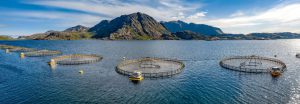Offshore and offshore aquaculture
At present, there are two types of aquaculture modes in China’s offshore and offshore areas: feeding and non-feeding. On the whole, the non-feeding aquaculture system is more sustainable than the feeding aquaculture system, and the offshore aquaculture system is more sustainable than the offshore aquaculture system.
2.1 Inshore aquaculture
The coastline of Chinese Mainland is more than 18000 km long, and the sea area within the – 20m isobath is about 160000 km2. The nearshore and offshore aquaculture in this sea area is an important part of China’s mariculture at present. In terms of shelled animal products, the output in 2018 accounted for about 55% of the total output of mariculture, and the output value accounted for about 26%.
In recent years, with the promotion of marine environmental protection and coastal zone comprehensive management, China’s offshore aquaculture is rapidly shrinking, and the traditional offshore aquaculture area is becoming a place for sightseeing, leisure, fishing, marine sports and other activities. Therefore, some scholars suggested that the offshore aquaculture industry should be gradually banned and some local governments have been practicing it. The transfer of nearshore aquaculture to offshore and offshore is the development trend of China’s marine aquaculture industry and the inevitable choice.
2.2 Offshore breeding
Offshore aquaculture is the main field for fishermen to change their jobs. Offshore culture includes feeding culture (such as large yellow croaker cage culture) and non-feeding culture (such as scallop culture). Although the proportion of offshore feeding aquaculture in China’s mariculture production is not high, the problems caused by it such as eutrophication of local water bodies, food safety risks, and disease transmission cannot be ignored. The development of offshore feeding aquaculture should not only consider the productive aquaculture capacity, but also consider the ecological aquaculture capacity and social aquaculture capacity, and improve the aquaculture efficiency, reduce the negative impact of aquaculture production, and balance the demands of all stakeholders through the implementation of multi-nutrient level comprehensive aquaculture and scientific planning.
Offshore non-feeding aquaculture includes filter-feeding shellfish and large algae aquaculture. Offshore non-feeding aquaculture is based on natural bait, with less artificial inputs and high sustainability. It is a aquaculture mode that can purify water quality, and its products meet the standards of organic products. However, the aquaculture scale in many sea areas in China has exceeded the aquaculture capacity. For example, compared with 1999, the cultivation area of scallops in China increased 11.3 times in 2018, but the cultivation output increased only 2.7 times. According to the ecological aquaculture capacity and social aquaculture capacity of the aquaculture water body, it is an effective way to raise the yield and economic benefits of the appropriate species and quantity of seedlings.
Filter-feeding shellfish can not only use natural food to form aquatic products, but also store carbon in their shells for a long time. Therefore, many scholars at home and abroad suggest that cultured bivalve shellfish be regarded as carbon sink products. However, many experts in marine biology and marine chemistry hold the opposite opinion, because every 1mol of CaCO3 generated by the shell during the calcification process will generate about 0.6mol of CO2 in the sea water. The field measurement results of shellfish culture sea areas also show that shellfish culture will increase the partial pressure of CO2 in the sea water. Scholars at home and abroad have not reached a consensus on the issue of shellfish carbon sink/source, which is probably due to different methodologies. So far, there is still a lack of an empirical study in situ, with clear spatio-temporal boundaries, including all nutrient levels of the aquaculture ecosystem.
2.3 High-sea aquaculture
With the advantages of broad expansion space, huge aquaculture capacity, less conflict with other sea use activities, good water quality and light parasitic diseases, open-sea aquaculture has gradually become the focus of attention at home and abroad. The disadvantages of offshore aquaculture vary from place to place. In addition to the technical difficulties, they also include high investment intensity, high risks, unclear property rights, and lack of corresponding legal protection. The European and American public are also concerned about its potential environmental impact and ecological losses.
The United States was one of the first countries to attempt to carry out pelagic aquaculture in the exclusive economic zone (EEZ, 3 – 200 nautical miles under federal jurisdiction). However, when the relevant bill was first proposed, it was opposed by many parties because of its potential fish disease transmission and aquaculture pollution. The situation did not change until the United States National Oceanic and Atmospheric Administration and the Ministry of Commerce jointly announced their support for the development of pelagic aquaculture in 2011. As the implementation of aquaculture in the EEZ of the United States is subject to multiple laws, there are only three shellfish aquaculture projects approved by the federal government for commercial or demonstration offshore aquaculture in 2019.
Unlike many European and American countries, China’s continental shelf is generally relatively flat, the offshore aquaculture waters are farther from the shoreline, the sea conditions are worse, and the investment and production costs of aquaculture facilities are relatively higher. Therefore, it is necessary to produce products with higher market prices to compensate for high investment and high breeding costs in China. The analysis of Hou Juan et al. (2020) shows that the sea area suitable for fish culture in China is far larger than that suitable for shellfish culture. Therefore, the development of high-value fish culture should become an important option for China’s offshore aquaculture. In order to reduce aquaculture pollution, improve economic benefits, and balance the benefits with other sea use activities, the production of pelagic aquaculture should also be arranged according to the ecological and social aquaculture capacity, and the integrated development of multi-nutrient level aquaculture and the complementary development of fisheries and electricity should be implemented.

